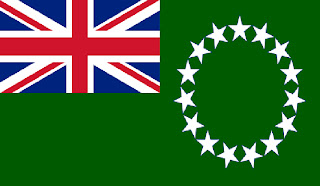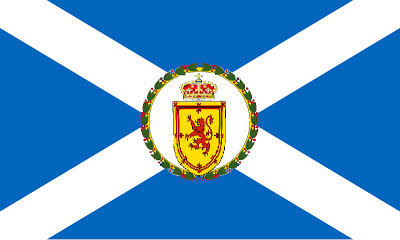As I have mentioned
before on my blog many world leaders have a personal flag. Now what has recently been brought to my attention is that the elected Leader of the United Kingdom the Prime Minister has no flag. The UK is considered one of the top players on the international stage (not as top as we might like to think but certainly in the top six or seven at least) so I think it is right that our leader has a personal flag.
Of course it could be argued the Monarch is the British leader and has the
Royal Standard, which is right however although in theory the monarch is the leader and all power comes from the crown, in practice the monarchy is only the figure head and does more public work such as opening hospitals, being patrons of charities and taking part of ceremonies of state. In fact the Queen very rarely addresses the nation Christmas day being the one regular address Compared to the Prime Minister who is head of the House of Commons and makes laws and holds numerous conferences and meetings.
Compare this picture of the US President:
Notice the President's flag on the right. Now look at the UK Prime Minister:
No Personal or office flag
The first design is for indoor purposes like the flags in the above pictures it can be displayed alongside the Union Flag:

It contains the coat of arms of "Her Majesty's Government" in the centre, the wreath is common on most diplomatic flags. It contains the shields of the four Constituent Countries: England(top left) Scotland(top right) Northern Ireland(bottom left) and Wales(bottom right). Northern Ireland is repressed by St Patrick's Cross because this is what represents it on the UK flag, and in the lack of an official flag is increasingly used alongside the other flags to represent NI, for example the Royal Barge Gloriana flew it to represent Ni at the Diamond Jubilee River Pageant. There is a red, white and blue boarder reflecting the national colours and I used a navy blue field as I think this colour when used like this has a rather official and authoritativeness feeling. The Text emphasise that this is the flag of the bearer of the office of Prime Minister rather than a political or personal flag. The Full title of the country is also used.
The Coat of Arms used by the government is different in Scotland than in the rest of the UK. So I made a separate flag to be used when the PM is making a speech or holding a conference in Scotland or specifically addressing the Scottish people:
First the coat of arms id that which is used in Scotland with the
Royal Arms of Scotland taking the dominant positions, The shield is surrounded by
thistles rather than a garter, the supporters have switched places (a unicorn traditionally being used on the Scottish arms and is now in the position of honour) and the crown of state being replaced with the
Crown of Scotland. The Scottish Saltire is also now in the canton rather than the fly. "United Kingdom" has been moved to the top and shortened to the name in common usage rather than the full name. "Office of the Prime Minister" in Scots and Scots Gaelic is in the bottom. The red, white and blue boarder has been replaced with a blue, whit, blue boarder reflecting the Scottish colours.
As I have stressed before these designs are for decorative indoor use. My idea for a flag for outdoor use (flown from buildings, cars, flag poles etc) is more conventional. A Union Flag with the Government coat of arms in the centre of the diplomatic wreath:
The problem is this flag is already in use! This is the flag used by British embassies all around the world!
So to make a more unique flag I took away the supporters and the motto:
The crown is also moved to rest on the shield rather than the garter. Again there is a separate Scottish variant but the only changes are the state crown being replaced with the Scottish one, the movement of the Scottish representation on the shield and the absence of a garter:
Scottish Variant
At present in the UK there is a coalition government. Meaning that two political parties are power sharing so there is a Deputy Prime Minister (DPM) from the lesser party shearing power. So in the case of coalitions I think the DPM should also have a flag. The DPM flag is based on the indoor flags except it is quartered with the full flag rather than a shield in each quarter.
Deputy Prime Minister Flag
Deputy PM Flag for use in Scotland
These are outdoor flags, the DPM can use the PM indoor flag for decoration as in a coalition this is supposed to be a shared office.
In the UK many of the Constituent Countries have their own local governments with devolved powers from the central government in Westminster for governing their own local and regional affairs. As such these regions have a secretary of state who represents the central British Government in the regional parliament or assembly, although they have little or no voting powers. Each region also has a First Minister who is the head the elected head of the regional government. I have also designed personal flags for these offices, there can also be coalitions at this level so I have also designed a secondary flag for the Deputy First Minister in this event.
First off in no particular order is Scotland. Now I have on other sites using an ensign type flag for the Scottish First Minister but this was for an independent Scotland.

For Scotland within the United Kingdom I suggest a saltire defaced with the Royal Arms of Scotland and Scottish Crown(as technically the FM is governing on the Queen's behalf):
The secondary flag for a Deputy First Minister is the same except there is a crowned thistle rather than a coat of arms:
The flag of the secretary of state for Scotland is a Union Flag(which will be standard for secretaries of state) defaced with the badge used by the Scotland Office of the British Government (Which is the Scottish version of the Government coat of arms):
This flag can be used on both sides of the boarder.
Next up is Northern Ireland. According to the terms of the Good Friday Agreement Unionists and Nationalists must share power so the NI government is always a coalition.
The flag of the First Minister is a St Patrick's Cross defaced with a gold harp on blue shield. This can be interceded as an
Irish Symbol or NI's Representation on both the
Royal and
Government coat of arms, and hence avoiding (in theory) any political sensitivities.
The flag of the deputy First Minister is the same except with the flax flower badge of the the Northern Ireland Assembly:
As is standard the flag of the secretary of state for Northern Ireland has a union flag. It is defaced with a coat of arms I designed for the Northern Ireland Office. Which is the same as the British coat of arms except the shield only contains a harp, but the crown, supporters, garter and motto are all unchanged.
The next country is Wales I have two proposals for the flag of the Welsh First Minister and secondary flag for use by a deputy First Minister in the event of a coalition.
The first flag is based on the National flag of Wales, the dragon flag:
The Flag of a Deputy First Minister features the Welsh Dragon Shield, topped by the crown of state in a plain circle similar to the garter design, and the Prince of Wales Feathers at the base, the design is inspired by the badge of the Wales Department of the UK Government:
The other proposals are the same badges but on a cross of St David:
First Minister
Deputy First Minister
The Flag for the secretary of state for Wales is a union flag defaced with the badge of the Wales Department:
Now England currently has no devolved government and is under direct rule from the central government of the United Kingdom. But you never no what could happen in the future. So here are flags for an English First Minister and Deputy First Minister and Secretary of State in-case England ever gets a devolved government. (although at present there is no real demand for one)
First Minister of England flag is St George's Cross defaced with the
Royal Arms of England and State Crown:
The Secondary flag for a deputy first minister is the same except it has a
Tudor rose. (Keeping with the flora designs of Scotland and N.Ireland's Deputy FM):
The Secretary of State for England will use the same badge but in a union Flag:
All Comments Welcome.
All designs are by Samuel McKittrick and reflect creativity and imagination and are designed to represent the respected offices not the individuals or political parties that occupy them.
























.bmp)































